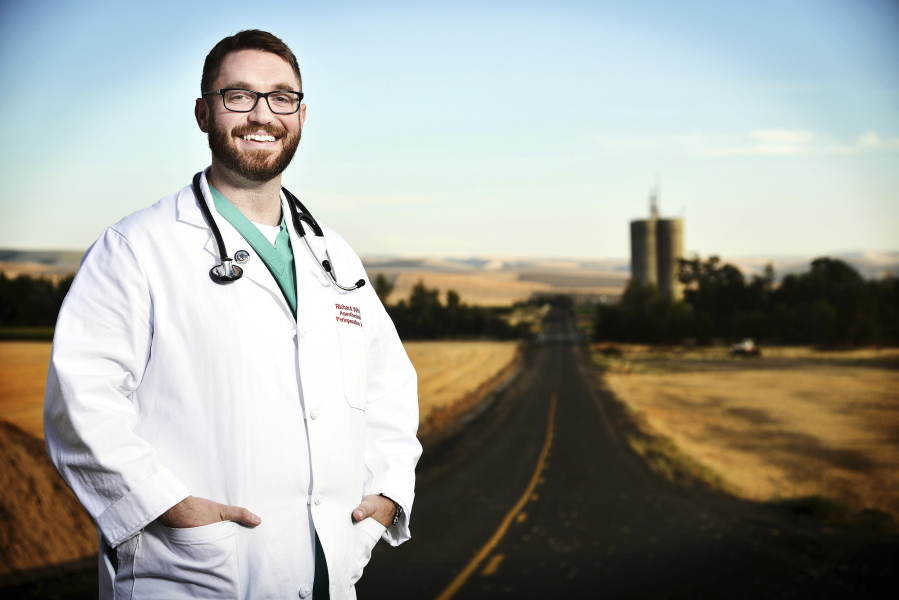PENDLETON, Ore. — When anesthesiologist Richard Wick opted to practice in rural Walla Walla after his residency last summer, the decision put him at odds with most of his classmates. Young physicians tend to flock to jobs in big cities.
Wick, who grew up in Pendleton, Ore., dreamed of being a doctor since boyhood and practicing in a rural area was always on the radar. His father, Ernest Wick, ran the radiology department at St. Anthony Hospital. The boy hung around the hospital, even shadowing Pendleton general surgeon John McBee. Wick always figured he would become a surgeon, but changed course during an anesthesiology rotation at the Creighton University School of Medicine in Nebraska. He loved the variety and the responsibility.
“In one day, I may care for a 9-month-old and a 90-year-old in different types of surgery,” Wick said. “I get to take care of people at their most critical moments. I watch their heart rate. I literally breathe for them.”
After finishing residency at Oregon Health & Science University, he and his wife Sarah considered where to practice. Richard felt comfortable with rural life, but Sarah had grown up in Portland and wasn’t as eager to leave the metropolis. In recruiting physicians to rural areas, it’s a common issue — a partners’ employment opportunities or simply the affinity for perks of urban life often come into play.
The couple, expecting a child and tired of Portland traffic, eventually embraced an anesthesiologist position at Walla Walla’s Providence St. Mary Medical Center.
“I love it,” Wick said.
It’s a happy outcome in a time of doctor shortages in rural America. The shortage, especially of primary care physicians, continues to worsen. That is partially due to an imbalance in pay between primary care doctors and specialists. According to Medscape’s 2017 Physician Compensation Report, orthopedists, cardiologists, plastic surgeons and urologists all earn $400,000 or more on average. But pediatricians, internists and family medicine doctors make $225,000 or less.
Maggie Elehwany, the National Rural Health Association’s vice president of government affairs, said rural America needs more doctors.
“Twenty percent of the population is scattered over 90 percent of the land mass,” she said. “This 20 percent of the population has nine percent of the physicians.” In addition, “there’s a higher percentage of chronic disease in rural America. They’re poorer and sicker.”
Oregon isn’t quite that low. Based on Oregon Medical Board licensures and the OHSU Office of Rural Health, 10,247 of Oregon doctors practice in urban/non-rural areas and 2,362 work in rural areas (defined as 10 miles or more away from a population center of at least 40,000).
The national shortage could grow to 45,000 by the year 2020, according to the NRHA. Since 2010, more than 80 rural hospitals have closed, including Walla Walla General Hospital.
Internist Norman Sitz is a popular Pendleton physician who is pondering retirement in the next couple of years. He worries about his patients when that time comes. He doesn’t have hard numbers but he knows his town is short on docs.
“People are always calling to get in,” Sitz said. “I don’t know what my patients are going to do.”
Sitz grew up in Ontario, so as a young internist he felt no qualms about practicing in a rural area. Though Pendleton wasn’t his first choice, he soon grew attached to this little place where “people get along with each other” and he has stayed for 40 years and counting. The locale was close to good hunting and fishing and proved a great place to raise his and wife Michelle’s three children. He doesn’t mind seeing his patients around town and his home number is in the book.
Sitz and his partner Daniel Marier sold their practice to the Praxis Medical Group three years ago as a way to rein in costs and get better bargaining power with insurance companies. The increasing regulation, complexity and requirements for such things as electronic health records have altered the landscape.
“You can’t open a small clinic now,” Sitz said. “There’s no way to do it on your own. Fifteen years ago, someone could come to Pendleton and open a small practice.”
Still, there are plenty of mid-level opportunities and not enough physicians to fill them.
Money isn’t necessarily the reason for reluctance to leave urban centers. Wick said doctors who go to rural areas often get paid more by employers as an incentive. Doctors, dentists, optometrists, nurses, physician assistants, nurse practitioners and certain others also receive up to $5,000 in annual tax credits to entice them to practice in rural Oregon. The Oregon Legislature recently renewed the credit, originally enacted in 1989.
A 2012 survey found that 45 percent of respondents felt the tax credit influenced their decision to practice in rural Oregon. More than 2,100 providers, including 60 in Pendleton and 76 in Hermiston, claimed the credit in 2015, the most recent data year available.
Barriers to a rural practice include resistance from partners, pressure to pay off debt and worry about being too far away from academia, specialists and the amenities of city life.
Some creative efforts aim to turn the tide. OHSU’s Area Health Education Centers, scattered around the state, introduce K-12 students to the notion of working in health care through career exploration activities. OHSU requires medical students to experience small town medicine during rotations in rural parts of the state.
Greggory Dallas, a second-year OHSU medical student from Pendleton, is one of several students with rural roots who helped organize rural medicine discovery trips to small towns this past year. The treks were designed to open urban medical students’ minds to rural medicine and remind rural students about reasons to return.
Dallas’ own plans are evolving. She left Pendleton in 2002 to attend Columbia University — in the center of New York City — not planning on returning home for a career.
“I assumed I’d be in a city,” she said. “I never imagined I’d be back in Pendleton.”



